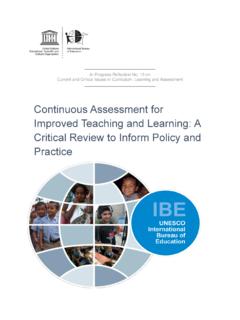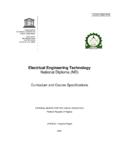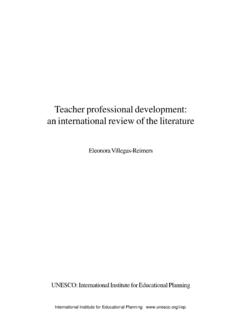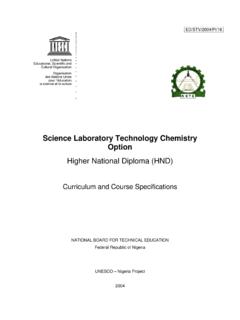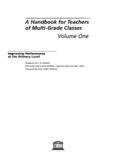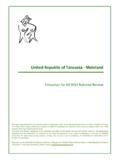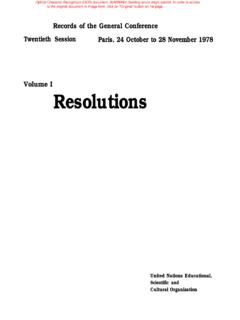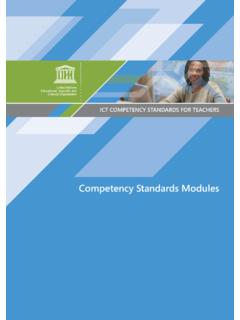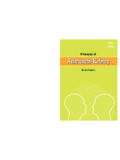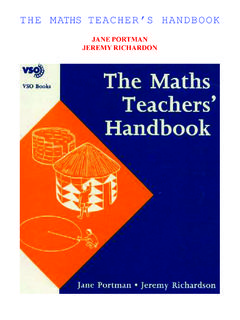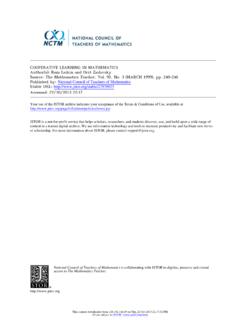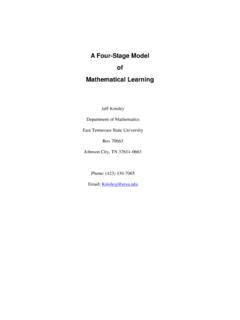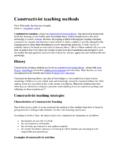Transcription of TEACHING AND LEARNING MATERIALS ANALYSIS …
1 - * UNESCO BASIC EDUCATION CAPACITY BUILDING PROJECT -TRAINING KITS FOR LOCAL NGOS- Dieme 3 TEACHING AND LEARNING MATERIALS ANALYSIS AND DEVELOPMENT IN BASIC EDUCATION Coordinated by: People s Action Forum Church House Lusaka ZAMBIA Written by Donald H. Chanda Sonnile Phiri Nkosha Edited By: Geoff Tambulukani Supported by: UNESCO Basic Education Division PARIS I- * . I About This M:~no:tl I he UNESCO supportqd project, Capacity Building for Local NGOs it1 13asic Ilrlucatioll in LDCs (BECAB) ailns at building up the capacity oi NC;Os to bcc;on~c partners of one another and governments in the delivery of basic education. The Project has as one of it s objectives, To develop a specilic training kit on NGO capacity buildinS in Basic Education that is adaptable to a wide range of NGOs.
2 Each country will develop a National Trainin, 1 kit to be incor-porated into a Global Kit. The Project embarked on this objective to develop lhe National Training Kit, [Phase II], in November 2000. To form the writing yroup, ten (10) ol the participants li~~nl lhe I998 series 01 BECAB Workshops were selected. These are: -Donald Chanda, Mr People s Aclioti Forum -Margaret Kamera, Ms People s Action Fonini -Innocent Kay&\, Mr Y out11 Association OF Zambia -Fred Libindo, MI Dcpt for Continuing Education \ -Emmanuel Mkanda, MI Fountain of l-lope Association -Regina Musokotwane, Ms FAWEZA -Felix Mwale, Mr Anglican Children s Projecl -Raphael Nakacinda, h4r Dept for Continuing Education -Sonnile Phiri, Ms RCZ-D~V~IO~I~I~III J rog:a~~me -Michael Siwale, Rev Adult Education Assoc.
3 Of Zambia Facilitating this whole process of wl-iliilg:, editing and produclio~~ ol lhc Inanuai was Mr GeoKT,ambulukani. BECAB Resource Person, Departnmit I-lcacl 01 Language and Social Sciences Education in the School of Education, University of Zambia. BECAB Project Assistant, Gina M. Fundafunda, assisted in the f acilitation process. Messrs Henry J. Msango, Nkosha, Bentry Nkhata, Nkoshn and Ms Irncd Mumba, all Icdturer-s with the University of Zambia, also aided the writing. It is hoped that this manual will be of invaluable assistance to the many Basic Education NGOs in the building up of their capacity to deliver quality education. Jennifer M. Chiwela NA I IONAL C OOlU>IN,4 7 oli, HIX AI~ Executive Director - People s Actioll FOIIII~ PREFACE This training manual was developed after it was realised that a lot of Non Governmental Organisatfbns lacked MATERIALS that would assist them in analysing and developing TEACHING and LEARNING MATERIALS , It contains information that we hope will be of assistance to the NGOs.
4 This Manual gives guidelines on how NGOs can develop their own teach and LEARNING MATERIALS (TLMs), especially that this is one of the, greatest needs among NGOs dealing with Basic Education in all its forms: formal, informal and non formal. There is also a section on evaluation of books which, it is hoped will be of great use to education providers. A lot of education providers, teachers, trainers and so forth, use many books which sometimes are not very helpful at all. It is hoped that teachers and trainers will find this section useful too. TABLE OF CONTENTS Page Preface..i Acknowledgements .,..iii Introduction: How To Use This Training .. , ..iv List of Training Strategies used in this manual.
5 V Abbreviations.. , ..v Unit 1: LEARNING and TEACHING MATERIALS .. I Unit 2: ANALYSIS and Choice of TEACHING and LEARNING MATERIALS ..7 Unit 3: Developing New TEACHING and LEARNING ..11 Unit 4: Unit 5: Evaluation and Review of TEACHING and LEARNING MATERIALS ..I7 Distribution and Care of TEACHING and LEARNING MATERIALS ..2 1 Module Test., .. _.. , .25 List of Accompanying Fact Sheets: The Use of TEACHING and LEARNING ..26 Glossary ..26 References ..28 ACKNOWLEDGEMENTS In preparing this manual for training in basic education, the authors wish to acknowledge the following for their support in many ways : UNESCO PAF RCZDP & PAP Our families Messrs G. Tambulukani, Nkosha & for the initiation of and financial assistance to the project for organising everything for releasing the two authors to do this wonderful work for supporting us during research and the actual writing Ms Gina Fundafimda for their invaluable assistance in the writing and editing Mrs R.
6 Tembo for typesetting and typing .. 111 INTRODUCTION How to use this Training Manual This training manual has been prepared for use by Basic Education trainers or teachers. The purpose of the manual is twofold: l to provide trainers and trainees with tools and guidelines for use in the provision of basic education l to enable trainers and trainees to choose, analyse, develop, use and evaluate their own TLMs. This manual can also be used by others directly or indirectly working in programmes aimed at improving the quality of basic education . The manual is arranged in five units. Each unit is subdivided into eight sections. To use this manual the trainer will first of all have to read all of it for clear understanding.
7 The trainer should decide which of the proposed training MATERIALS are available and which ones he/she will have to prepare. The trainer must also decide which training method he/she will use and what preparations to make. The glossary or list of special temnnologies, and abbreviations, which have been used in this manual, are adequately explained in order to help the trainers and trainees to understand the manual. There is also a module test at the end of Unit 5. This is aimed at establishing how much knowledge the trainees have grasped from their training. The trainers are free to prepare additional questions to assess trainees understanding of any other aspects covered in this manual.
8 There is a list of accompanying fact sheets after Unit 5, which the trainer will refer to for more information or explanation on the use of TEACHING and LEARNING MATERIALS . The purpose of providing this information is to enable the trainer to prepare and present his/her lesson with less difficulties and to ensure that the lesson is relevant to the needs of the trainees. The references section provides additional sources of the material that the trainers/trainees can use in their lessons. It should be noted that the information given in this trianing manual is aimed at simply providing guidelines. Trainers are, therefore, free to think of and use as many innovative strategies as possible.
9 Iv LIST OF TRAINING STRATEGIES USED IN THIS MANUAL The following are the suggested strategies that can be used in this training manual: l classroom presentation l lecture method l group work l pair work l individual work l role plays l brainstorming l class discussions/debates ABBREVIATIONS PAF: People s Action Forum TLMs: TEACHING and LEARNING MATERIALS VIPP: Visual Image UNESCO: United Nations Educational, Scientific and Cultural Organisation RCZ: Reformed Church in Zambia Development Programme V UNIT 1: TEACHING AND LEARNING MATERIALS AIM: The aim of this unit is to enable trainees to develop and analyse TEACHING and LEARNING MATERIALS EXPECTED LEARNING OUTCOMES By the end of this unit, trainees should be able to: l differentiate between TEACHING and LEARNING MATERIALS .
10 L justify the purpose and importance of TEACHING and LEARNING MATERIALS . l identify the different types of TEACHING and LEARNING MATERIALS . l develop strategies of using teacl::ng and LEARNING MATERIALS . l develop strategies for the effective use of TEACHING and LEARNING MATERIALS . CONTENT SUMMARY 1. Definition of TEACHING and LEARNING MATERIALS . 2. Purpose and importance of TEACHING and LEARNING MATERIALS . 3. Types of TEACHING and LEARNING MATERIALS . 4. Strategies of using TEACHING and LEARNING MATERIALS . 5. Strategies for effective use of TEACHING and LEARNING MATERIALS . PROPOSED TRAINING STRATEGIES The trainer can use any of the following strategies: l pair/group work l brainstorming l role plays l lectures l classroom presentations PROPOSED TRAINING MATERIALS The trainer can use any of the following MATERIALS : l TEACHING and LEARNING MATERIALS manual l VIPP cards 0 Flip charts l Felt pens/markers l Exercise/note books l Activity sheets 0 Chalk/black boards.
